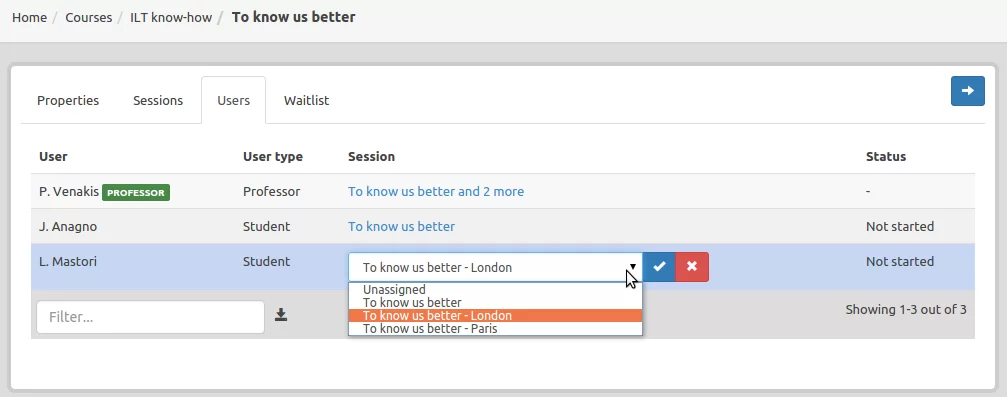eFront, for example, treats in-person training as a first class option alongside online courses — allowing Instructors to create, manage, and monitor instructor-led training courses from the same intuitive interface with which they manage their “conventional” eLearning sessions.
Just like web-based courses, instructors can schedule new in-person training courses (classroom- or webinar-based), have them appear on student calendars, control their enrollment options (in the case of limited seats etc.), track them through reports, and finally grade them and use them to award certificates and permit further student progress.
The option for online instructor-led training is also independent of what kind of eLearning program you use eFront for. You can combine it with corporate training, talent development, onboarding, etc., or even run it alongside your commercial eLearning offerings.
eFront doesn’t restrict you there; it’s all about what best fits each particular learning scenario and whether in-person tutoring has any advantages for your use cases. For example, ILT is better for teaching subjects that involve complex interactions in the physical world or when instructors need to be able to evaluate learners’ responses in real time.
Instructor-led training in eFront
Instructor-led training in eFront is based on two simple notions: Events and Sessions.
An Event represents the teaching of an individual lesson unit and can have one or more (online or in-person) Sessions where that teaching actually takes place.
This is because, unlike web-based lessons which learners can study at any time, instructor-led training requires the booking of classrooms that fit a limited amount of learners, or involves real-time webinars with limited virtual “seats”.
For this reason, and to be able to accommodate all the learners that have enrolled in your ILT Event, eFront allows you to break it down to multiple sessions (involving e.g. different classrooms with several instructors teaching at the same time, or a single classroom/instructor giving several lectures, or finally multiple webinars).
To give a concrete example, a specific “Sales Training Basics” seminar would represent a “Training Event” in eFront’s terminology. If you have 120 people attending while your classroom only holds 80 people, or if you need to accommodate learners with different availability, you’ll schedule multiple “Training Sessions” at different times (and/or places) to cover your event.
It really is that simple — and if you understand Events and Sessions, you already know most of what you need to know regarding ILT in eFront.
eFront is also smart enough to handle a number of details for you behind the scenes. For example, if you have classrooms with limited capacities, eFront will automatically enforce your attendance caps and prevent learners from over-enrolling to the same event.
Similarly, if you have multiple independent instructors scheduling ILT sessions, eFront will prevent them from unknowingly assigning the same physical classroom for more than one session at the same time.
Working with ILT Events in eFront
To create a new Training Event or Session, or manage existing ones, you need to be logged in as an eFront instructor or administrator.
ILT management follows the same procedures and concepts, regardless of whether your instructor-led online training courses are implemented as webinars, teleconference sessions, or traditional classroom-based lectures.
ILT training is combined with eLearning in eFront in a “Blended Learning” course — “Blended Learning” being a standard industry term for training that combines ILT and conventional web-based learning content (other names include “hybrid learning” and “in-person training”).
After you’ve created your Blended Learning course, you can visit the Lessons and Events tab to create your Training Events, through which you’ll add your training sessions. The default Training Events and Training Sessions views show all your existing Events and Sessions in the typical eFront style, with buttons to edit or delete existing entries or to add new ones.
When you create a new Training Event you need to give it a name (e.g. “Sales Training seminar”), a date, a duration, and a location, which can be online, in the case of a webinar. You can also add an (optional but useful) short description.
Session configuration is, as you probably expect, quite similar. Note that your eFront administrators will need to configure a teleconference option in System Settings / Integrations / Conferences if your instructor-led training design includes webinars. You can use the built-in BigBlueButton, Webex or Webinar.ru services for your synchronous distance learning sessions. And soon, you’ll also be able to use GoToMeeting and iLinc, plus a few more services that are under integration.
From the Users tab of your ILT Event, you can see any enrolled learners (including those on the waitlist), and you have the option to assign learners directly to a session.
Similarly, after the event is completed, instructors can mark attendances and/or grades in the aptly named “Attendance/Progress” tab in a Training Event’s management page.
Any scheduled ILT training and upcoming sessions will be shown on your learners’ eFront calendar. Learners will also receive invitations via email (in the industry standard iCal format), with the option to register training events that interest them (given that there’s enough capacity).
For webinars, once the session is ready to start, learners are able to join by clicking the aptly titled “Join” button in the Training Event’s dashboard.
Conclusion
While classroom-based training might go out of style in favor of cheaper, more flexible online instructor-led training options, webinars and real-time training sessions are poised to become even more important in the future.
In any case, instructor-led training is an important tool to have in your eLearning arsenal, and eFront offers everything you might need to seamlessly incorporate hybrid learning in your corporate or commercial training scenarios.
